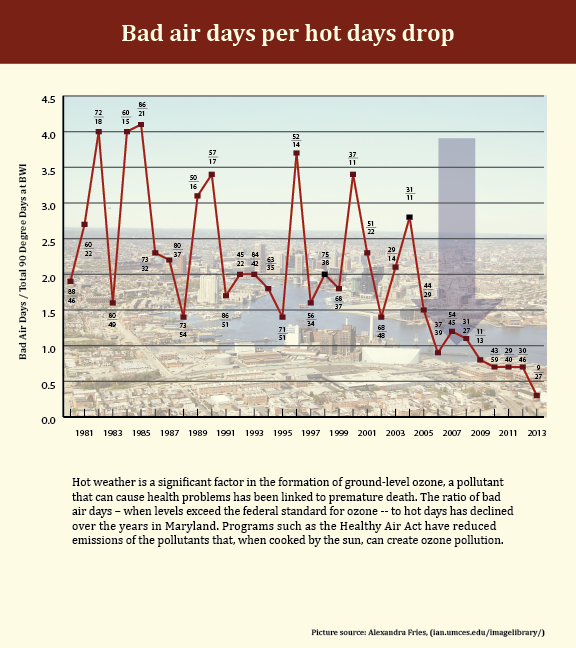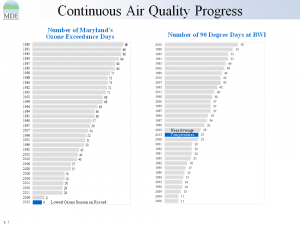Air Quality Awareness Week 2014
Last year, Maryland’s air was the cleanest in the three decades that ground level ozone has been measured. Hot summer sunshine generally increases the amount of ground-level ozone in our air, and that causes health issues for many Marylanders with asthma or other respiratory problems. Last summer had a nearly average number of hot days – but the number of days when the ozone standard was exceeded was the lowest yet measured and the days that exceeded the standard were “Code Orange” days. There were no “Code Red” days.
Thanks to decades of sustained efforts and the continued strong support of Maryland’s air quality programs by the O’Malley-Brown administration, overall, results of 2013 air quality monitoring data show continued improvements in our state’s air quality, but there is more to be done. Maryland is taking steps to address the pollution from power plants in neighboring states that are a major source of Maryland’s ozone problem.
This week is Air Quality Awareness Week. MDE encourages everyone to follow our air quality forecasts and take the steps listed below to help keep Maryland’s air clean.
“Breathing clean air is something most of us take for granted. But if you have respiratory concerns such as asthma, poor air quality is something that can’t be ignored,” said MDE Secretary Robert M. Summers. “We all make choices every day that can help reduce air pollution.”
What you can do:
- Conserve energy by turning off lights and appliances when you leave a room.
- Use energy efficient appliances such as refrigerators, air conditioners, heat pumps and furnaces
- Reduce, Reuse, Recycle to conserve energy and reduce emissions.
- When possible, walk, bike or use public transportation.
- Do not idle your vehicle’s engine – keep the air clean and save fuel.
- Maintain your vehicles in good working order and check tire pressure regularly.
- Shop with reusable bags instead of using paper or plastic.
- Plant trees in locations around your home to provide shade in the summer.
- Follow air quality forecasts and plan your outdoor activity as appropriate.
- Put off mowing the lawn or painting and reduce driving on bad air days.
Ozone is monitored and forecasted to protect the public from high concentrations that can irritate the respiratory system. Ground-level ozone has also been linked to premature death.
Levels are typically at their highest between May and September, when ozone is frequently the most serious air pollutant in the Mid-Atlantic region. The increase occurs as warm temperatures, intense sunlight and light winds of the warm season increase production of ground-level ozone.
In 2013, the ozone standard was exceeded on only nine days – compared to more than 50 in 2007.
Reducing air pollution improves public health, and actions that reduce pollution also help restore the Chesapeake Bay. In recent years Maryland has implemented the Maryland Healthy Air Act, the toughest power plant emissions law on the East Coast, and the Maryland Clean Cars Program. Maryland participates in the Regional Greenhouse Gas Initiative and has established a plan to reduce greenhouse gas emissions by 25 percent by 2020 through energy conservation, increased use of renewable energy and other programs that can also help our air quality.
However, the science demonstrates clearly that Maryland cannot fully meet the air quality standards that protect public health unless air pollution generated outside of our borders is controlled. Research indicates that states upwind of Maryland are responsible for as much as 70 percent of Maryland’s air quality problems. In December, Maryland was among a group of Northeast and Mid-Atlantic states that petitioned the U.S. Environmental Protection Agency to require upwind states to reduce air emissions that are carried by prevailing winds to contribute to the formation of ozone in downwind states. Maryland and other downwind states also were parties in support of EPA in a Supreme Court review of a lower court ruling that vacated EPA’s Cross-State Air Pollution Rule, which addresses air pollution from power plants that contributes to unhealthy air in downwind states. On April 29, the Supreme Court upheld that rule.
To mark Air Quality Awareness Week and the coming of summer, MDE reminds residents to take steps to protect their health and the air we breathe. For air quality forecasts and information on air quality, go to MDE’s website or to cleanairpartners.net, where you can sign up to receive emailed air quality alerts. Clean Air Partners also offers a free smart phone app to receive air quality forecasts. You can also call MDE’s air quality hotline at 410-537-3247.


